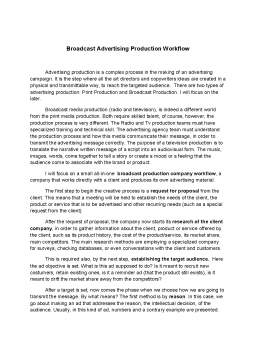Extras din referat
Advertising production is a complex process in the making of an advertising campaign. It is the step where all the art directors and copywriters ideas are created in a physical and transmittable way, to reach the targeted audience. There are two types of advertising production: Print Production and Broadcast Production. I will focus on the later.
Broadcast media production (radio and television), is indeed a different world from the print media production. Both require skilled talent, of course, however, the production process is very different. The Radio and Tv production teams must have specialized training and technical skill. The advertising agency team must understand the production process and how this media communicate their message, in order to transmit the advertising message correctly. The purpose of a television production is to translate the narrative written message of a script into an audiovisual form. The music, images, words, come together to tell a story or create a mood or a feeling that the audience come to associate with the brand or product.
I will focus on a small all-in-one broadcast production company workflow, a company that works directly with a client and produces its own advertising material.
The first step to begin the creative process is a request for proposal from the client. This means that a meeting will be held to establish the needs of the client, the product or service that is to be advertised and other recurring needs (such as a special request from the client).
After the request of proposal, the company now starts its research of the client company, in order to gather information about the client, product or service offered by the client, such as its product history, the cost of the product/service, its market share, main competitors. The main research methods are employing a specialized company for surveys, checking databases, or even conversations with the client and customers.
This is required also, by the next step, establishing the target audience. Here the ad objective is set. What is this ad supposed to do? Is it meant to recruit new costumers, retain existing ones, is it a reminder ad (that the product still exists), is it meant to drift the market share away from the competitors?
After a target is set, now comes the phase when we choose how we are going to transmit the message. By what means? The first method is by reason. In this case, we go about making an ad that addresses the reason, the intellectual decision, of the audience. Usually, in this kind of ad, numbers and a contrary example are presented.
The second approach is emotion. This requires triggering an emotional response in the target audience, commonly by presenting a situation that is emotionally close to the target audience, for example a love story between two characters or a death of a loved pet.
Thirdly, we have humor. This way, the message gets to the audience easily. The form of the message makes them laugh, so the audience is more perceptible to advertising messages. It has been proven that sometimes, the audience would buy the product or service only because of the way the message was presented, not the actual content of the advertising message.
The forth and last main approach is through fear. They are often employed in public service announcements, such as those seeking to discourage smoking, reduce the road toll, warn of the dangers of hard drugs. For example: “Every 5 minutes someone has a heart attack. You could be next!”
Finally, after deciding on an approach, we move on to the next stage, which is selecting a presentation style. The main styles are:
a. Problem/solution presentation: In this type of ad, we present an occurring problem, such as a stain on the carpet, and the product-solution.
b. Demonstration: We present the effectiveness of the product, usually in comparison to another product of the same type.
c. Spokesperson: Here we assign a face to the product or service, by selecting a spokesperson that sustains the product in front of an audience.
d. Testimonials: In this type of advert there are two or more persons talking about their good experiences with the product and explain that the product made their life easier.
e. Musical formats: These commercials usually employ a memorable or impact song in combination with images that sustain it. It looks very much like a videoclip, most commonly used in sportswear and perfume commercials.
f. Montage: Using a fast paced cut between shots and contextualization, the images obtain a different meaning than what they would suggest if not being assigned together. Example: A close-up of a chef admiring his finished meal, then a fast-food type menu on the table.
g. Symbolism: Using powerful symbols to suggest an attitude or a meaning. Example: a rose for romance.
h. Narrative commercial: Presenting a situation.
Preview document
Conținut arhivă zip
- Broadcast Advertising Production.doc






